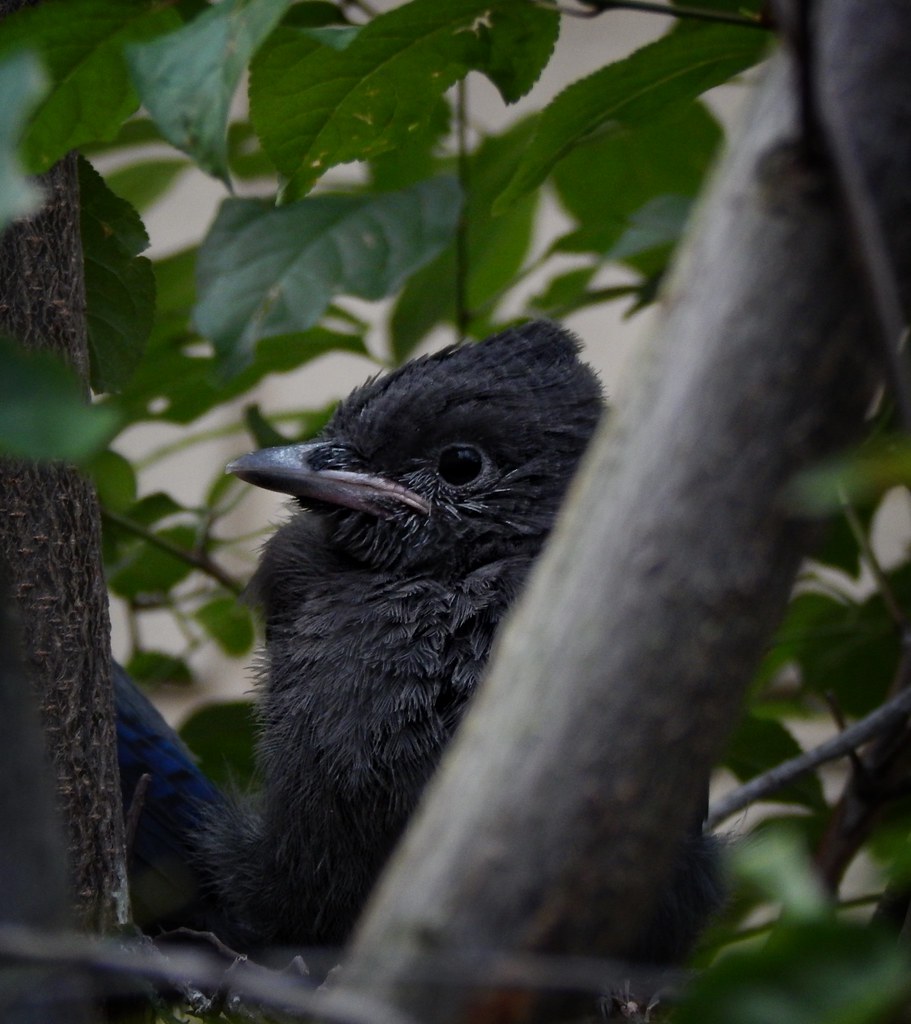Photography
Related: About this forumBaby Steller's Jay
Last edited Sun Jun 5, 2016, 04:13 PM - Edit history (1)
Taken while standing in my bathtub, having removed the screen from the window. There were three of them and they fledged shortly after I took this photo.
[url=https://flic.kr/p/GWFfSY][img] [/img][/url][url=https://flic.kr/p/GWFfSY]
[/img][/url][url=https://flic.kr/p/GWFfSY]
CaliforniaPeggy
(149,588 posts)elleng
(130,865 posts)(Does one hug a Baby Stellar Jay???)
NV Whino
(20,886 posts)elleng
(130,865 posts)Consider it done!
![]()
mnhtnbb
(31,384 posts)We had a nest of baby cardinals right by our front door this spring. When we were packing to go to the beach a couple of weeks ago,
I was carrying some stuff out to the car and one of the babies was in the middle of our walkway! It was in the sun
and looking stressed. I ran in to get my garden gloves, picked it up, and moved it under the tree where the nest was--in the shade--
and back towards the front deck of the house. No sign of it when we returned from the beach, so I hope it was ok.
mindfulNJ
(2,367 posts)eppur_se_muova
(36,260 posts)Early scientific visitor to Alaska with Vitus Bering's second (and last) expedition, died on the return trip across Siberia due to disease and the negligence of his Russian guards.
https://en.wikipedia.org/wiki/Georg_Wilhelm_Steller
A man worth reading about; his Wikipedia entry is fairly concise. He accomplished a lot before his untimely death.
I remember when we took a vacation out West I was excited the first time I spotted a Steller's Jay, because it meant to me we were really 'out West'.
https://www.allaboutbirds.org/guide/Stellers_Jay/lifehistory
Our blue jays here (north AL) seem much darker than I remember from childhood. I've read there is some hybridization going on between Eastern Blue Jays and western Steller's, but can't confirm that is what is happening here.
NV Whino
(20,886 posts)Thanks for the info. I had no idea of the jay's history.
When I moved here over thirty years ago, they used to migrate through. On their way to the Sierras, I guess. Now they are here full time. Just one or two pairs, but it's such a delight to see them. They are so much more polite than the abundant scrub jays.
eppur_se_muova
(36,260 posts)somewhat like this:

... and so the story of Steller's recognition of this relative of the Eastern Blue Jay (which he had seen in Audobon's paintings) really stuck in my memory.
Of course, I grew up knowing that the two continents were separate, but it was actually centuries after Columbus before this was realized with certainty. For all the coverage of European colonization of the Americas I saw in school, there was very, very little mention of the Russian explorers -- we learned about "Seward's Folly", but that was about it.
The Russian colonization of the Americas followed in the late 18th and early 19th centuries, through the joint efforts of the state and private enterprises such as the Russian-American Company, led by Grigory Shelikhov, Nikolay Rezanov, Alexander Baranov and others. Russians mapped most of the Alaskan coasts and nearby islands, explored the inner areas of the peninsula, and went as far south as Fort Ross in California.[11]
In 1803–06 the first Russian circumnavigation was led by Ivan Kruzenshtern and Yury Lisyansky, partly with the aim of establishing direct marine communications between Saint Petersburg and Russian America. More Russian circumnavigations followed, notably those led by Otto Kotzebue, Ferdinand Wrangel and Fyodor Litke. These voyages brought multiple discoveries in Alaska and the Pacific. In 1820-1821 a round-the-world expedition led by Faddey Bellingshausen and Mikhail Lazarev on sloops Vostok and Mirny discovered the continent of Antarctica.[12]
https://en.wikipedia.org/wiki/List_of_Russian_explorers
Of course, it's hard not to suspect a political motivation, but chances are the textbook authors didn't even know this stuff.